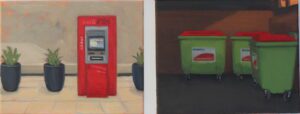Peirce and Christina Baehr, along with their growing family, run a hostel in Tasmania’s Huon Valley. It attracts backpackers from all over the world and throughout the peak (fruit-picking) season, they host regular dinners with their guests. One would think that in the off-season they’d enjoy a break and, to some extent, they do. But they also use that time to round up an army of volunteers and stage a multi-day art exhibition, complete with workshops, performances and prizes. All this might sound like a recipe for exhaustion. Sometimes it is. But they’re not doing any of it on their own. And sometimes, it doesn’t feel like work at all. After all, they’re living their dream.
The dream started to take shape more than fifteen years ago when, just after marrying, the pair prayerfully considered how their gifts might fit together. They decided that, God-willing, they’d build a family-run hostel that would offer distinctly Christian hospitality to travellers, and a residency program to artists—a place not unlike Francis and Edith Schaeffer’s L’Abri.
Raising the necessary funds and starting to plan and build Pilgrim Hill took years. In the meantime, they started a family; they started showing hospitality to travellers in the Huon community by running free dinners in existing venues; and they started supporting Christian artists by running the Pilgrim Artists’ Festival.
At first, Peirce and Christina thought of the annual festival as a temporary substitute for the artist’s residency they planned to build on the hill one day. But now they expect it to continue—it’s become “its own thing”.
Art Is Important to God
When I ask the couple why art is so important to them, they answer that art is important to God. Christina notes that the means by which God communicates to us today is through a work of literary art.
“In times where people become more rationalist and utilitarian, they often struggle with that, like, why is Song of Songs in the Bible? Do we really need so many Psalms?!” Peirce adds that in Exodus 31, God fills craftsmen with the Spirit; with wisdom, understanding, knowledge and “all kinds of skills” so they can make art for the tent of meeting.
“And if you follow up on these items over the next few pages, you find intricate artistry and design for so many elements.”
The fact beauty matters to God is clear from the God’s word—and God’s creation. “When you look around at the world, you’d have to really be quite blind not to understand how important beauty is to God,” Christina says. “The world is full of completely useless things… There’s so much lavish, extraneous beauty around us; it would be really hard to argue that beauty or art are not important to God.”
Closer to Home
The Baehrs also see “extraneous beauty” play an important role in their home life. “For instance, we designed the large living space in our home to be a place where people would feel welcomed to come in and share meals with us and share the Bible with us,” Christina says. Part of this involved hanging original art on their walls. They didn’t first think, “What art can we hang on our walls that will make people understand what we value?” she says. “But by hanging beautiful art on the walls that does reflect our values, it has actually become a huge talking point, and also just a way that people can understand who we are.”
Peirce notes that none of the works they’ve hung are “overtly religious”. They’re mostly portraiture by Christina’s mother, Margaret Sonnemann, and artworks by their children; though there are two somewhat unusual oil paintings by a local artist.

“Peirce was insistent we get these two pieces by Emily Jones. I was like, this is a little surprising… Do I really want a picture of a trash can and an ATM on my wall?” Christina says. But she went along with it, placing the paintings above a portrait of her with one of their children, “and it’s become a really wonderful thing to contemplate”.

“It’s a very Ecclesiastes pairing of pictures,” she says. “It reminds me of times when Jesus [says], don’t worry about tomorrow, the body is more than clothing, and life is more than what you possess; it reminds me that human beings are eternal, it reminds me not to worry.”
Peirce says “It spoke to me very deeply” of the futility of consumerism. “We buy, we trash, we buy and we trash; [but] human life is not like that.”
“It has also been a great talking point for the travellers,” Christina says. “When we were discussing Ecclesiastes recently, I could just point to these paintings, and everyone completely got it; instantly.”
A Way to Bless Artists and the Community
Christina says a key goal of the festival—which exhibits a curated selection of entries from Christian artists of all ages—is to support established artists and inspire budding artists.
“We’ve seen a lot of ways in which artists have been encouraged: how they’ve been encouraged in their gifts [and] how they’ve been encouraged to meet with other Christians who are artists,” Peirce says. “I think it was festival three that we started to step back and see: this has developed its own community. It’s no longer just us, there’s actually a community here of artists who are interacting with each other.”
The opportunity to submit and exhibit work is unique, and has seen many Christians motivated to create works that wouldn’t otherwise exist. Peirce and Christina are also aware of friendships and collaborations that are happening as a result of the festival; which has created “an atmosphere where things were able to germinate faster, or in ways that maybe wouldn’t have happened before”, Christina says.
This means a lot to the couple, who realise that time spent creating art isn’t always rewarded, financially or otherwise. It can also be undervalued by fellow believers who question whether it’s a godly use of time that could be spent in other ways. “The church doesn’t always understand, and the art world doesn’t always understand,” Peirce says.
“I wish we could encourage them more,” Christina says. “I wish more people would come and buy the art, because honestly, the most encouragement that you can give a Christian artist is actually to pay money for their work.
“Sometimes people are like, ‘Oh, I’ll pay you with exposure’, so we’re trying to not be that, we’re trying to be a bit more substantial than that by actually offering prizes, and hopefully encouraging people to buy their work, and also just with the validation of saying, we see you, we value you, and your craftsmanship is worth pursuing for God’s glory.”
Although Christina describes the volunteer-run festival as “very local, very grounded, very grassroots”, it has attracted international support, entries, and visitors. It also features thirty (mostly cash) prizes, including a $1000 people’s choice award.
“We welcome submissions from anywhere,” Peirce notes. “Technically it’s a bit challenging to get the actual physical submissions, but we have had some from other countries come through, and the literary prizes are easy to apply for from any place on the planet.”
While the festival is designed to showcase the work of Christian artists (entrants are asked to affirm the Nicene creed), it also seeks to bless the local community more broadly. As far as Peirce and Christina can tell, it’s doing that too; they’re fairly certain most of the people who walk into the exhibition off the street aren’t churchgoers. Some look at the art, some cast a people’s choice vote, some attend a workshop.
“They’re not necessarily going to get the entirety of the gospel, but they might get a piece of it,” Christina says. “They might come out and go, ‘Woah, Christians care about justice’, or ‘Wow, these Christians are really good at noticing the beauty in the world’, or they might come in and go, ‘Oh, I thought Christians were very closed and insular, but they’re really welcoming and they’re offering this stuff for free.’”
She recalls a top graphic novelist from overseas who came across last year’s festival by chance. “He just walked in and went into a self-publishing workshop that one of our Christian authors was running, and he was blown away … He was definitely not a Christian, but he came in and we were able to serve him, we were able to help him. He spent ages looking at all the art … he read the stories, he was voting on stuff, he was deeply engaging with all of the work.”
A World Infused with Beauty
Not everything that’s submitted to the festival makes the cut—teams of volunteer “curators” filter the entries each year, but Peirce says there are always works that amaze him. Each entry is assessed based on three criteria: how well it fits the prompt, how skilfully it’s made, and whether it’s saying something true.
This year’s theme is “beauty in the everyday”.
“In the past, sometimes we’ve gone for really big, expansive, epic themes, like ‘justice and mercy’, and some of our artists have thrived on that,” Christina says. ‘But other artists, maybe their genres are like textiles or still life, they’ve kind of gone, how am I going to do ‘justice and mercy’?
“This year is great, you can essentially go big or small as you want, and beauty in the everyday is something that most people can identify with through any genre and any medium,” she says.
“And it gives us a chance to recognise the fact God has given us this world, that is just so insanely infused with beauty.”














